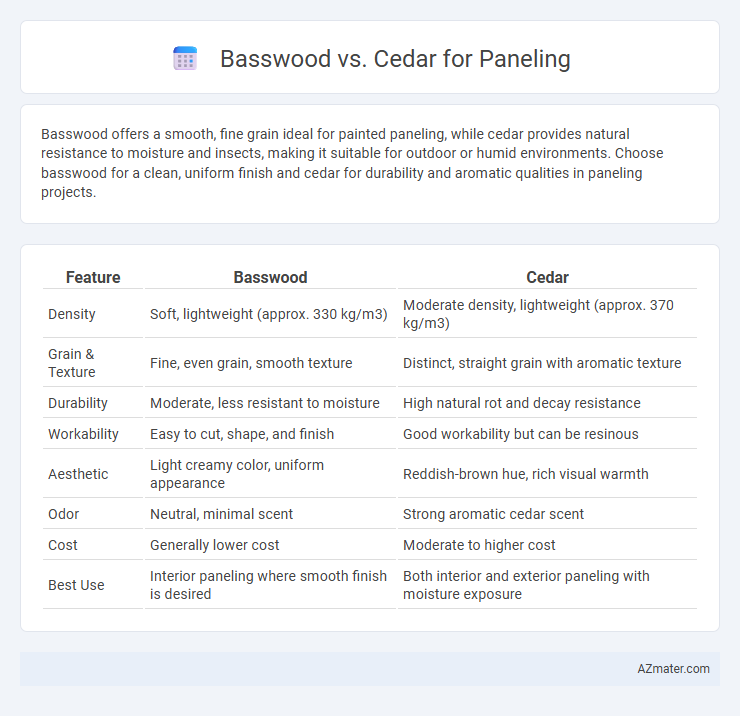Basswood offers a smooth, fine grain ideal for painted paneling, while cedar provides natural resistance to moisture and insects, making it suitable for outdoor or humid environments. Choose basswood for a clean, uniform finish and cedar for durability and aromatic qualities in paneling projects.
Table of Comparison
| Feature | Basswood | Cedar |
|---|---|---|
| Density | Soft, lightweight (approx. 330 kg/m3) | Moderate density, lightweight (approx. 370 kg/m3) |
| Grain & Texture | Fine, even grain, smooth texture | Distinct, straight grain with aromatic texture |
| Durability | Moderate, less resistant to moisture | High natural rot and decay resistance |
| Workability | Easy to cut, shape, and finish | Good workability but can be resinous |
| Aesthetic | Light creamy color, uniform appearance | Reddish-brown hue, rich visual warmth |
| Odor | Neutral, minimal scent | Strong aromatic cedar scent |
| Cost | Generally lower cost | Moderate to higher cost |
| Best Use | Interior paneling where smooth finish is desired | Both interior and exterior paneling with moisture exposure |
Introduction: Comparing Basswood and Cedar for Paneling
Basswood and cedar are popular choices for paneling, each offering distinct characteristics suited to various interior designs. Basswood is known for its fine, even texture and pale color, making it ideal for painted finishes and detailed woodwork. Cedar provides natural resistance to moisture and decay, featuring a warm tone and aromatic scent that enhance cozy, rustic environments.
Basswood Overview: Characteristics and Uses
Basswood offers a fine, uniform texture and light color, making it ideal for smooth, paint-ready paneling surfaces. Its softness allows for easy cutting and carving, which is favored in decorative interior paneling applications. Commonly used in cabinetry, furniture, and acoustic paneling, basswood provides a stable, lightweight option compared to the aromatic and more resinous cedar.
Cedar Overview: Characteristics and Uses
Cedar is a lightweight wood known for its natural resistance to decay, insects, and moisture, making it an excellent choice for paneling in humid or outdoor environments. Its distinctive aromatic scent and rich color variations from reddish-brown to lighter tones enhance aesthetic appeal and create a warm, inviting atmosphere. Cedar's dimensional stability and ease of working with hand or power tools contribute to its popularity for interior wall coverings, ceilings, and decorative paneling applications.
Visual Appeal: Grain, Color, and Texture
Basswood paneling offers a smooth, fine grain with a light, creamy color that brightens interior spaces, making it ideal for painted or stained finishes. Cedar paneling features a rich spectrum of reddish-brown hues and a pronounced, straight grain that adds warmth and natural character to walls. Texture-wise, basswood is softer and uniform, while cedar has a slightly rougher feel with natural knots, enhancing rustic or cabin-style aesthetics.
Durability and Longevity
Basswood offers moderate durability with a fine, even texture suitable for interior paneling but is less resistant to moisture and decay compared to cedar. Cedar is well-known for its natural resistance to rot, insects, and weather, making it a longer-lasting option for paneling in both indoor and outdoor environments. Choosing cedar paneling ensures enhanced longevity and durability, particularly in areas prone to humidity and temperature fluctuations.
Workability: Cutting, Shaping, and Installation
Basswood offers exceptional workability for paneling, characterized by its softness and fine, even grain that allows for easy cutting and shaping without splintering. Cedar, while slightly harder, still provides good workability but requires sharper tools to achieve clean cuts and smooth shaping due to its natural oils and resin content. Installation of both woods is straightforward; however, basswood's uniform texture facilitates precise fitting, whereas cedar's dimensional stability enhances long-term performance in varying humidity conditions.
Weight and Density Comparison
Basswood has a density of approximately 410 kg/m3, making it lighter and easier to handle compared to cedar, which has a density ranging from 320 to 370 kg/m3 depending on the species. Despite its slightly higher density, cedar's natural oils provide better resistance to rot and insects, making it more durable for paneling in exterior applications. The lighter weight of basswood makes it ideal for interior paneling projects where ease of installation and minimal structural load are priorities.
Natural Resistance: Insects, Rot, and Decay
Basswood offers moderate natural resistance to insects and decay but is more susceptible to rot compared to cedar, making it less ideal for high-moisture environments. Cedar exhibits superior resistance to insects, rot, and decay due to its natural oils and extractives, which act as effective preservatives without chemical treatments. For paneling in areas prone to moisture and pest exposure, cedar provides a longer-lasting and more durable solution than basswood.
Cost and Availability
Basswood paneling typically costs more than cedar due to its fine grain and smooth finish, making it a preferred choice for detailed interior work. Cedar is widely available and often less expensive, favored for its natural resistance to moisture and insects, which contributes to lower long-term maintenance costs. Both woods vary regionally in price and availability, with cedar being more abundant in North American markets compared to basswood.
Best Applications: Choosing the Right Wood for Your Project
Basswood offers a smooth, fine-grained surface ideal for detailed carvings and painted paneling, making it perfect for interior projects that require a clean finish. Cedar provides natural resistance to moisture, decay, and insects, making it the best choice for exterior or high-humidity environments like bathrooms and saunas. Selecting basswood ensures easy painting and intricate designs, while cedar enhances longevity and durability in weather-exposed or damp areas.

Infographic: Basswood vs Cedar for Paneling
 azmater.com
azmater.com